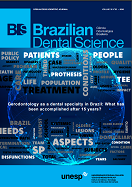Effects of Different Polishing Systems on the Surface Roughness of Two Ceromers
DOI:
https://doi.org/10.14295/bds.2016.v19i2.1241Resumo
Objective: This in vitro study evaluated the effects of three polishing systems on the surface roughness of two ceromers. Material and Methods: 96 specimens (8 mm in diameter and 2 mm thick) were prepared in a metal mold using two restorative materials: CERAMAGE (Shofu, Japan) and VMLC VITA (VITA Zahnfabrik, Germany). The specimens were divided into 4 groups (n=12): G1: positive control, Mylar strip; G2: abrasive tips, Edenta system; G3: silicon tips, Enhance system; and G4: abrasive tips, Shofu system. The parameter evaluated was the average surface roughness (Ra) determined by using a profilometer SJ 301 (Mitutoyo, Japan), followed by photographic evaluation images through Scanning Electron Microscopy (SEM), with a 1000x magnification range. The data was subjected to statistical analysis for comparison between the groups (ANOVA, Tukey and Student T-tests), with a significance level of 5%. Results: there was a statistically significant difference between the silicone tip Enhance and the other groups for both ceromers with higher values of surface roughness. There was no statistically significant difference between the ceromers, except for the Shofu system, which showed lower values of surface roughness for Vita VMLC. Conclusion: Within the limitations of this study, it was concluded that the Edenta and Shofu abrasive tips are more effective in reducing the surface roughness of ceromers compared with the Enhance silicone tip.
Keywords: Resins; Surface roughness; Dental polishing.
Downloads
Downloads
Publicado
Como Citar
Edição
Seção
Licença
TRANSFERÊNCIA DE DIREITOS AUTORAIS E DECLARAÇÃO DE RESPONSABILIDADE
Toda a propriedade de direitos autorais do artigo "____________________________________________________________________" é transferido do autor(es) para a CIÊNCIA ODONTOLÓGICA BRASILEIRA, no caso do trabalho ser publicado. O artigo não foi publicado em outro lugar e não foi submetido simultaneamente para publicação em outra revista.
Vimos por meio deste, atestar que trabalho é original e não apresenta dados manipulados, fraude ou plágio. Fizemos contribuição científica significativa para o estudo e estamos cientes dos dados apresentados e de acordo com a versão final do artigo. Assumimos total responsabilidade pelos aspectos éticos do estudo.
Este texto deve ser impresso e assinado por todos os autores. A versão digitalizada deverá ser apresentada como arquivo suplementar durante o processo de submissão.




























